Painting the flesh
Artists' Techniques
Three of the main artists (Hands A, B and C) modelled flesh tones on a lead white base (e.g. fols. VIr, 42r, 191v). Hand B, and occasionally Hand C, added a touch of red on the cheeks (e.g. fols. 42r, 177v). Facial features and hair were outlined with fluid carbon black lines.
Hand D used a pink colour instead for the base layer in flesh tones (e.g. fol. 220r). He rendered facial features and other anatomical details in a sophisticated way, with brown shadows and white highlights yielding a more realistic effect.




Deposition (Hours of the Virgin, Vespers)
The deep blue and dark purple draperies (hotspot 1), skilfully modelled so as to convey the three-dimensional human anatomy beneath, and the pink flesh tones of Christ’s body (hotspots 2 and 3) characterise the work of Hand D.